Appraisal of Conceptual Design Process for Green Building Systems
VerifiedAdded on 2023/06/08
|17
|4446
|73
Report
AI Summary
This report provides an appraisal of the conceptual design process for environmentally friendly building systems, emphasizing the importance of resource efficiency throughout a building's lifecycle. It highlights the needs definition for such buildings, focusing on minimizing environmental impact and promoting human health through efficient use of water, energy, and other resources. The report details the steps involved in the conceptual design process, including understanding the problem, data collection, analyzing existing buildings, processing information, selecting the best options, creating building models and sketches, and integrating relevant tools for construction, operation, maintenance, and demolition. It also stresses the significance of stakeholder input and continuous improvement to ensure the sustainability of the building system. The goal is to optimize building design to reduce resource consumption, protect the environment, and improve public health.
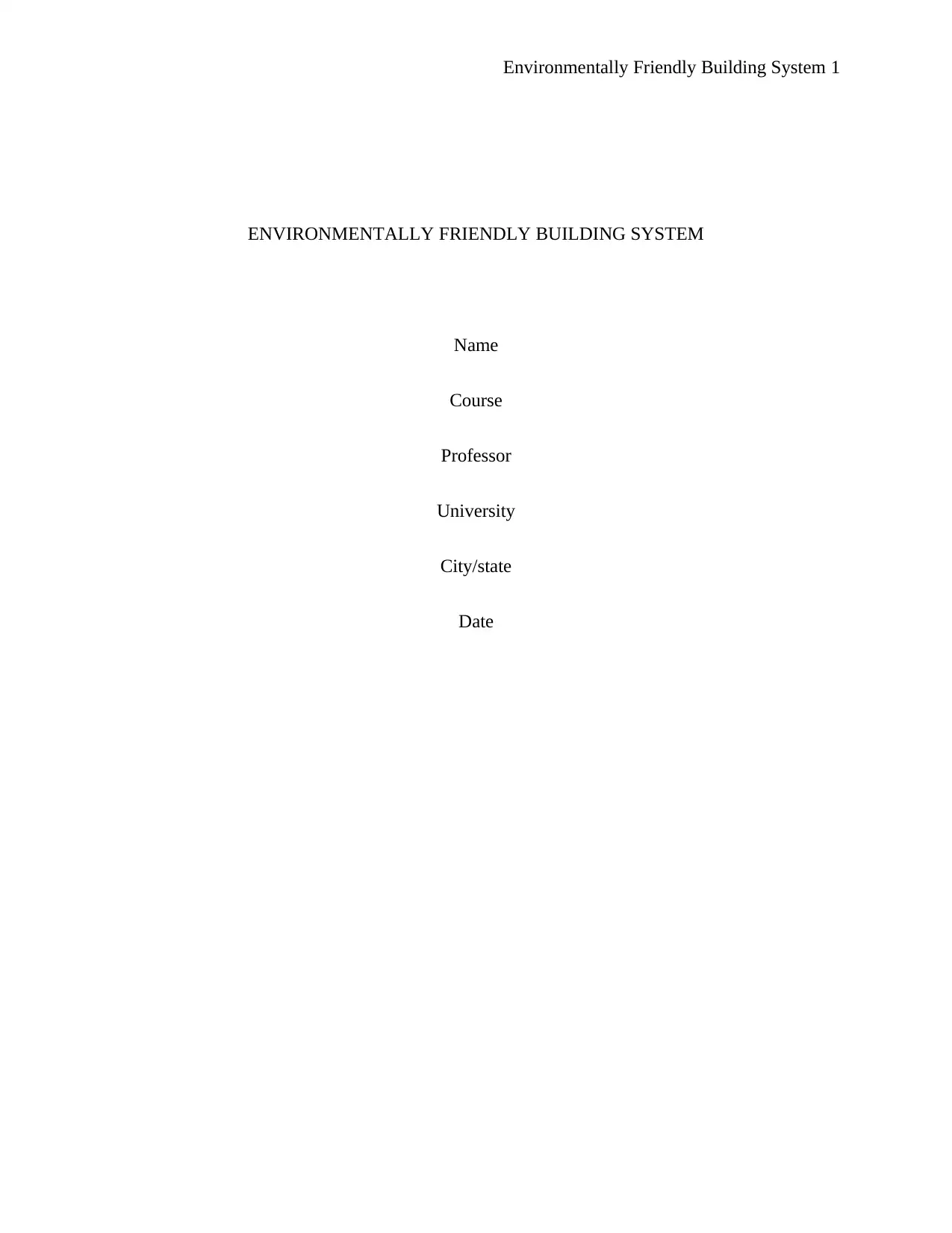
Environmentally Friendly Building System 1
ENVIRONMENTALLY FRIENDLY BUILDING SYSTEM
Name
Course
Professor
University
City/state
Date
ENVIRONMENTALLY FRIENDLY BUILDING SYSTEM
Name
Course
Professor
University
City/state
Date
Paraphrase This Document
Need a fresh take? Get an instant paraphrase of this document with our AI Paraphraser
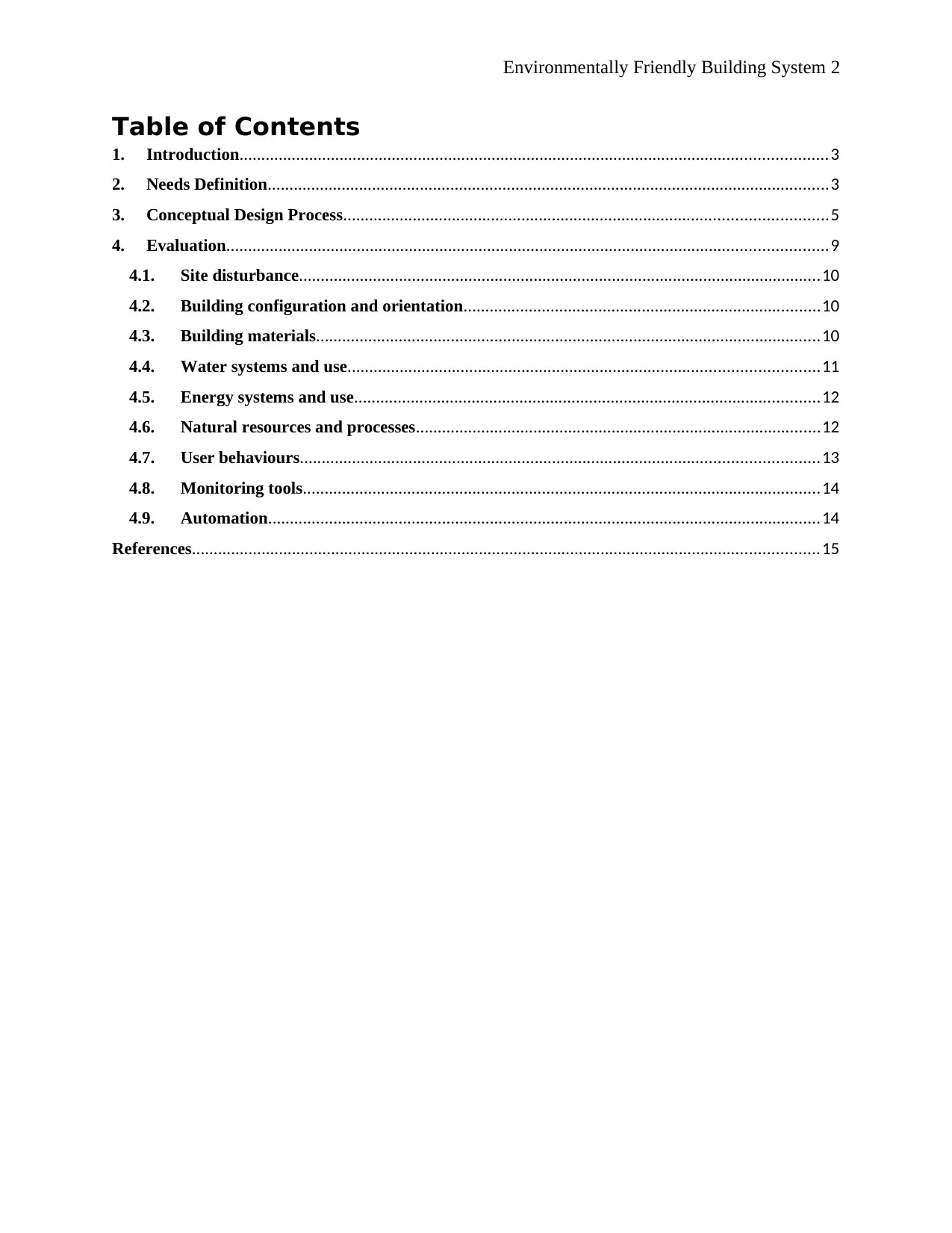
Environmentally Friendly Building System 2
Table of Contents
1. Introduction.......................................................................................................................................3
2. Needs Definition.................................................................................................................................3
3. Conceptual Design Process...............................................................................................................5
4. Evaluation..........................................................................................................................................9
4.1. Site disturbance........................................................................................................................10
4.2. Building configuration and orientation..................................................................................10
4.3. Building materials....................................................................................................................10
4.4. Water systems and use............................................................................................................11
4.5. Energy systems and use...........................................................................................................12
4.6. Natural resources and processes.............................................................................................12
4.7. User behaviours.......................................................................................................................13
4.8. Monitoring tools.......................................................................................................................14
4.9. Automation...............................................................................................................................14
References................................................................................................................................................15
Table of Contents
1. Introduction.......................................................................................................................................3
2. Needs Definition.................................................................................................................................3
3. Conceptual Design Process...............................................................................................................5
4. Evaluation..........................................................................................................................................9
4.1. Site disturbance........................................................................................................................10
4.2. Building configuration and orientation..................................................................................10
4.3. Building materials....................................................................................................................10
4.4. Water systems and use............................................................................................................11
4.5. Energy systems and use...........................................................................................................12
4.6. Natural resources and processes.............................................................................................12
4.7. User behaviours.......................................................................................................................13
4.8. Monitoring tools.......................................................................................................................14
4.9. Automation...............................................................................................................................14
References................................................................................................................................................15
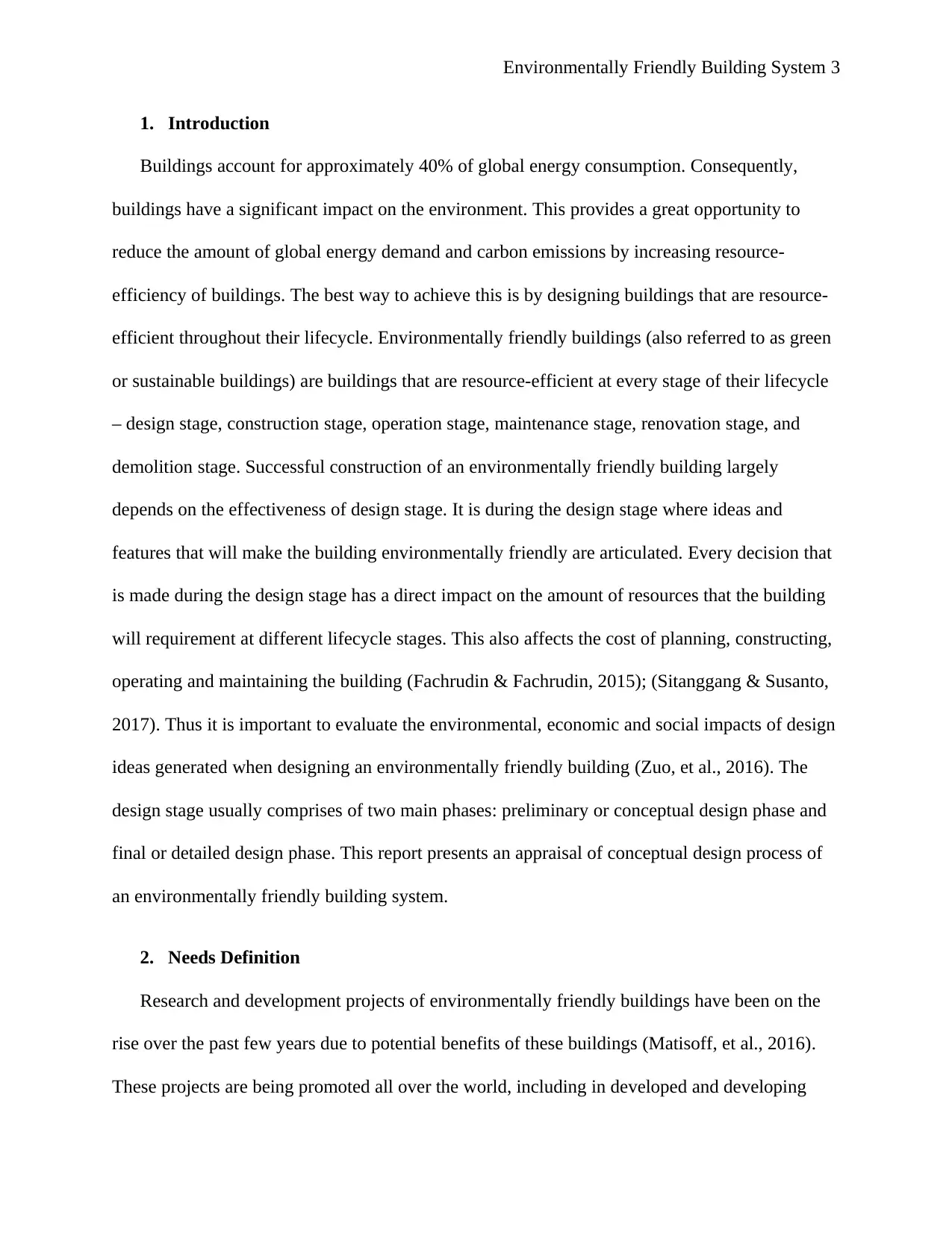
Environmentally Friendly Building System 3
1. Introduction
Buildings account for approximately 40% of global energy consumption. Consequently,
buildings have a significant impact on the environment. This provides a great opportunity to
reduce the amount of global energy demand and carbon emissions by increasing resource-
efficiency of buildings. The best way to achieve this is by designing buildings that are resource-
efficient throughout their lifecycle. Environmentally friendly buildings (also referred to as green
or sustainable buildings) are buildings that are resource-efficient at every stage of their lifecycle
– design stage, construction stage, operation stage, maintenance stage, renovation stage, and
demolition stage. Successful construction of an environmentally friendly building largely
depends on the effectiveness of design stage. It is during the design stage where ideas and
features that will make the building environmentally friendly are articulated. Every decision that
is made during the design stage has a direct impact on the amount of resources that the building
will requirement at different lifecycle stages. This also affects the cost of planning, constructing,
operating and maintaining the building (Fachrudin & Fachrudin, 2015); (Sitanggang & Susanto,
2017). Thus it is important to evaluate the environmental, economic and social impacts of design
ideas generated when designing an environmentally friendly building (Zuo, et al., 2016). The
design stage usually comprises of two main phases: preliminary or conceptual design phase and
final or detailed design phase. This report presents an appraisal of conceptual design process of
an environmentally friendly building system.
2. Needs Definition
Research and development projects of environmentally friendly buildings have been on the
rise over the past few years due to potential benefits of these buildings (Matisoff, et al., 2016).
These projects are being promoted all over the world, including in developed and developing
1. Introduction
Buildings account for approximately 40% of global energy consumption. Consequently,
buildings have a significant impact on the environment. This provides a great opportunity to
reduce the amount of global energy demand and carbon emissions by increasing resource-
efficiency of buildings. The best way to achieve this is by designing buildings that are resource-
efficient throughout their lifecycle. Environmentally friendly buildings (also referred to as green
or sustainable buildings) are buildings that are resource-efficient at every stage of their lifecycle
– design stage, construction stage, operation stage, maintenance stage, renovation stage, and
demolition stage. Successful construction of an environmentally friendly building largely
depends on the effectiveness of design stage. It is during the design stage where ideas and
features that will make the building environmentally friendly are articulated. Every decision that
is made during the design stage has a direct impact on the amount of resources that the building
will requirement at different lifecycle stages. This also affects the cost of planning, constructing,
operating and maintaining the building (Fachrudin & Fachrudin, 2015); (Sitanggang & Susanto,
2017). Thus it is important to evaluate the environmental, economic and social impacts of design
ideas generated when designing an environmentally friendly building (Zuo, et al., 2016). The
design stage usually comprises of two main phases: preliminary or conceptual design phase and
final or detailed design phase. This report presents an appraisal of conceptual design process of
an environmentally friendly building system.
2. Needs Definition
Research and development projects of environmentally friendly buildings have been on the
rise over the past few years due to potential benefits of these buildings (Matisoff, et al., 2016).
These projects are being promoted all over the world, including in developed and developing
⊘ This is a preview!⊘
Do you want full access?
Subscribe today to unlock all pages.

Trusted by 1+ million students worldwide
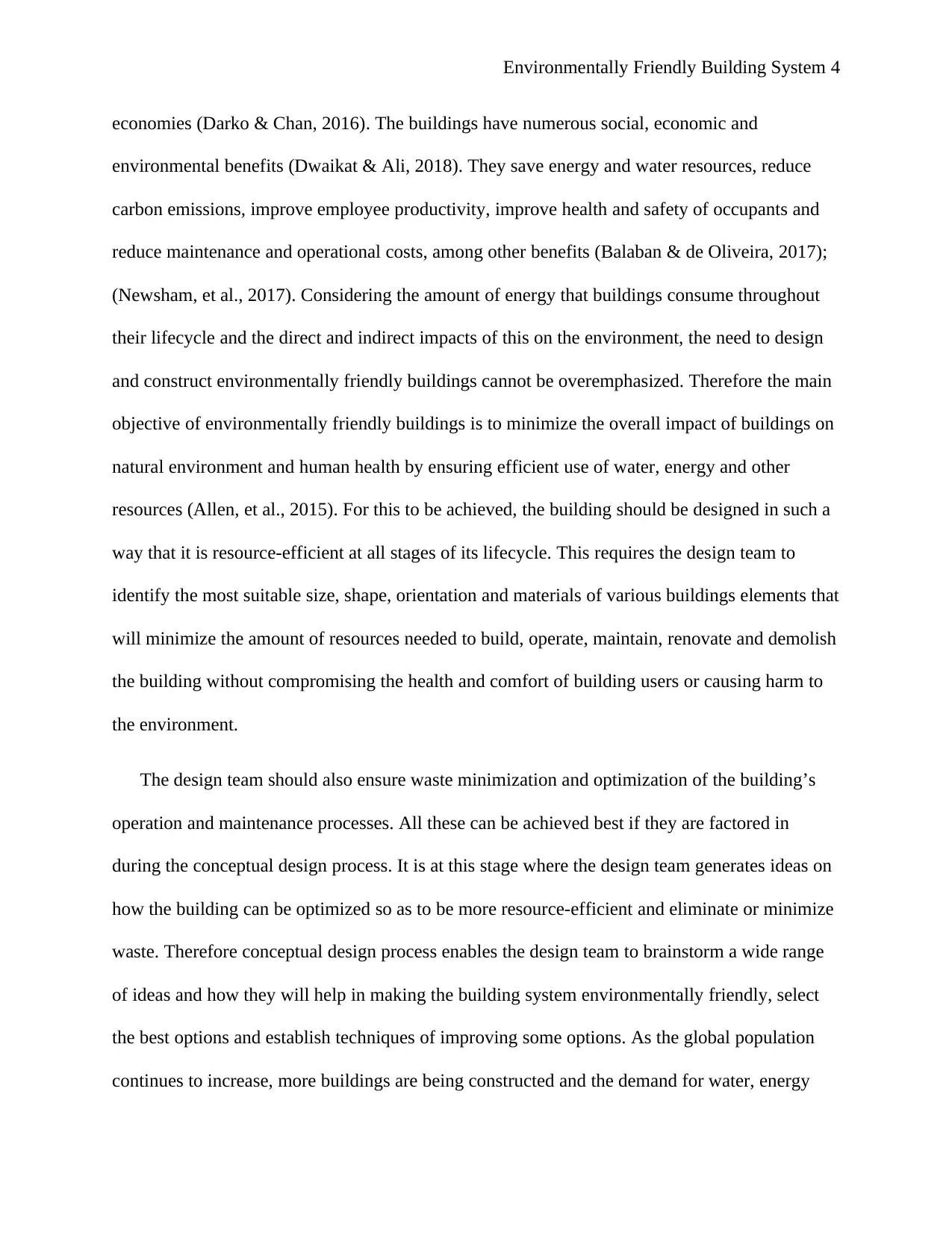
Environmentally Friendly Building System 4
economies (Darko & Chan, 2016). The buildings have numerous social, economic and
environmental benefits (Dwaikat & Ali, 2018). They save energy and water resources, reduce
carbon emissions, improve employee productivity, improve health and safety of occupants and
reduce maintenance and operational costs, among other benefits (Balaban & de Oliveira, 2017);
(Newsham, et al., 2017). Considering the amount of energy that buildings consume throughout
their lifecycle and the direct and indirect impacts of this on the environment, the need to design
and construct environmentally friendly buildings cannot be overemphasized. Therefore the main
objective of environmentally friendly buildings is to minimize the overall impact of buildings on
natural environment and human health by ensuring efficient use of water, energy and other
resources (Allen, et al., 2015). For this to be achieved, the building should be designed in such a
way that it is resource-efficient at all stages of its lifecycle. This requires the design team to
identify the most suitable size, shape, orientation and materials of various buildings elements that
will minimize the amount of resources needed to build, operate, maintain, renovate and demolish
the building without compromising the health and comfort of building users or causing harm to
the environment.
The design team should also ensure waste minimization and optimization of the building’s
operation and maintenance processes. All these can be achieved best if they are factored in
during the conceptual design process. It is at this stage where the design team generates ideas on
how the building can be optimized so as to be more resource-efficient and eliminate or minimize
waste. Therefore conceptual design process enables the design team to brainstorm a wide range
of ideas and how they will help in making the building system environmentally friendly, select
the best options and establish techniques of improving some options. As the global population
continues to increase, more buildings are being constructed and the demand for water, energy
economies (Darko & Chan, 2016). The buildings have numerous social, economic and
environmental benefits (Dwaikat & Ali, 2018). They save energy and water resources, reduce
carbon emissions, improve employee productivity, improve health and safety of occupants and
reduce maintenance and operational costs, among other benefits (Balaban & de Oliveira, 2017);
(Newsham, et al., 2017). Considering the amount of energy that buildings consume throughout
their lifecycle and the direct and indirect impacts of this on the environment, the need to design
and construct environmentally friendly buildings cannot be overemphasized. Therefore the main
objective of environmentally friendly buildings is to minimize the overall impact of buildings on
natural environment and human health by ensuring efficient use of water, energy and other
resources (Allen, et al., 2015). For this to be achieved, the building should be designed in such a
way that it is resource-efficient at all stages of its lifecycle. This requires the design team to
identify the most suitable size, shape, orientation and materials of various buildings elements that
will minimize the amount of resources needed to build, operate, maintain, renovate and demolish
the building without compromising the health and comfort of building users or causing harm to
the environment.
The design team should also ensure waste minimization and optimization of the building’s
operation and maintenance processes. All these can be achieved best if they are factored in
during the conceptual design process. It is at this stage where the design team generates ideas on
how the building can be optimized so as to be more resource-efficient and eliminate or minimize
waste. Therefore conceptual design process enables the design team to brainstorm a wide range
of ideas and how they will help in making the building system environmentally friendly, select
the best options and establish techniques of improving some options. As the global population
continues to increase, more buildings are being constructed and the demand for water, energy
Paraphrase This Document
Need a fresh take? Get an instant paraphrase of this document with our AI Paraphraser
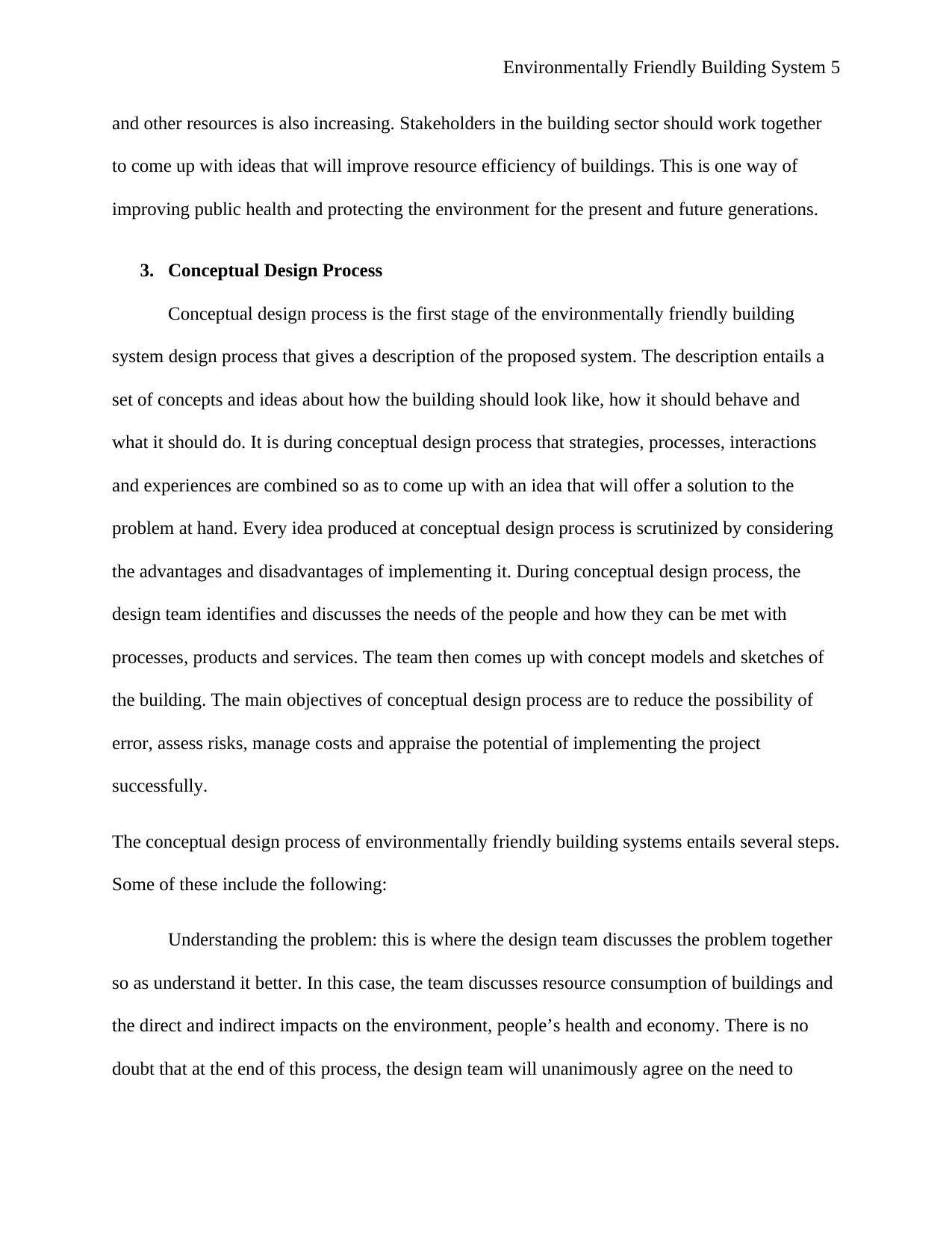
Environmentally Friendly Building System 5
and other resources is also increasing. Stakeholders in the building sector should work together
to come up with ideas that will improve resource efficiency of buildings. This is one way of
improving public health and protecting the environment for the present and future generations.
3. Conceptual Design Process
Conceptual design process is the first stage of the environmentally friendly building
system design process that gives a description of the proposed system. The description entails a
set of concepts and ideas about how the building should look like, how it should behave and
what it should do. It is during conceptual design process that strategies, processes, interactions
and experiences are combined so as to come up with an idea that will offer a solution to the
problem at hand. Every idea produced at conceptual design process is scrutinized by considering
the advantages and disadvantages of implementing it. During conceptual design process, the
design team identifies and discusses the needs of the people and how they can be met with
processes, products and services. The team then comes up with concept models and sketches of
the building. The main objectives of conceptual design process are to reduce the possibility of
error, assess risks, manage costs and appraise the potential of implementing the project
successfully.
The conceptual design process of environmentally friendly building systems entails several steps.
Some of these include the following:
Understanding the problem: this is where the design team discusses the problem together
so as understand it better. In this case, the team discusses resource consumption of buildings and
the direct and indirect impacts on the environment, people’s health and economy. There is no
doubt that at the end of this process, the design team will unanimously agree on the need to
and other resources is also increasing. Stakeholders in the building sector should work together
to come up with ideas that will improve resource efficiency of buildings. This is one way of
improving public health and protecting the environment for the present and future generations.
3. Conceptual Design Process
Conceptual design process is the first stage of the environmentally friendly building
system design process that gives a description of the proposed system. The description entails a
set of concepts and ideas about how the building should look like, how it should behave and
what it should do. It is during conceptual design process that strategies, processes, interactions
and experiences are combined so as to come up with an idea that will offer a solution to the
problem at hand. Every idea produced at conceptual design process is scrutinized by considering
the advantages and disadvantages of implementing it. During conceptual design process, the
design team identifies and discusses the needs of the people and how they can be met with
processes, products and services. The team then comes up with concept models and sketches of
the building. The main objectives of conceptual design process are to reduce the possibility of
error, assess risks, manage costs and appraise the potential of implementing the project
successfully.
The conceptual design process of environmentally friendly building systems entails several steps.
Some of these include the following:
Understanding the problem: this is where the design team discusses the problem together
so as understand it better. In this case, the team discusses resource consumption of buildings and
the direct and indirect impacts on the environment, people’s health and economy. There is no
doubt that at the end of this process, the design team will unanimously agree on the need to
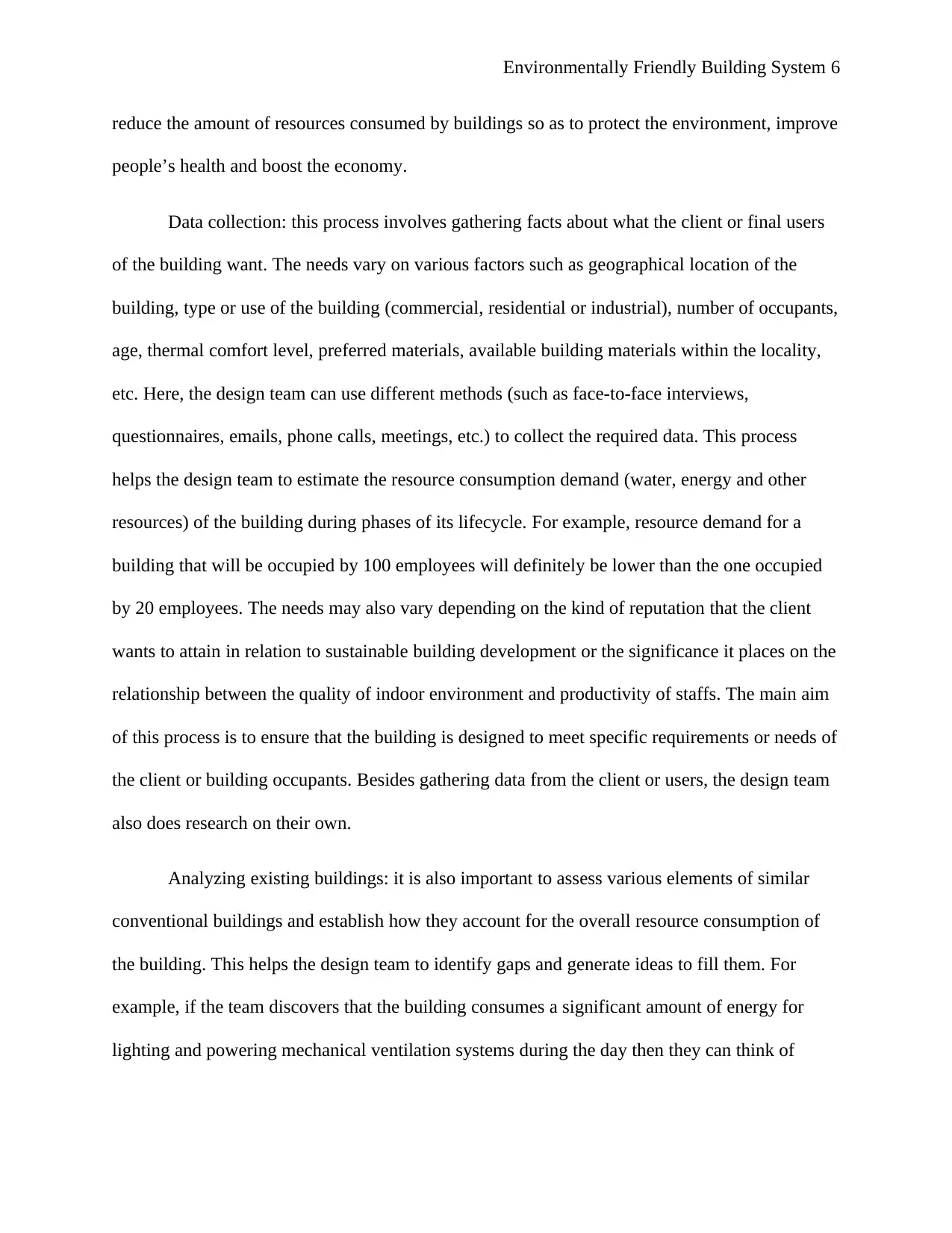
Environmentally Friendly Building System 6
reduce the amount of resources consumed by buildings so as to protect the environment, improve
people’s health and boost the economy.
Data collection: this process involves gathering facts about what the client or final users
of the building want. The needs vary on various factors such as geographical location of the
building, type or use of the building (commercial, residential or industrial), number of occupants,
age, thermal comfort level, preferred materials, available building materials within the locality,
etc. Here, the design team can use different methods (such as face-to-face interviews,
questionnaires, emails, phone calls, meetings, etc.) to collect the required data. This process
helps the design team to estimate the resource consumption demand (water, energy and other
resources) of the building during phases of its lifecycle. For example, resource demand for a
building that will be occupied by 100 employees will definitely be lower than the one occupied
by 20 employees. The needs may also vary depending on the kind of reputation that the client
wants to attain in relation to sustainable building development or the significance it places on the
relationship between the quality of indoor environment and productivity of staffs. The main aim
of this process is to ensure that the building is designed to meet specific requirements or needs of
the client or building occupants. Besides gathering data from the client or users, the design team
also does research on their own.
Analyzing existing buildings: it is also important to assess various elements of similar
conventional buildings and establish how they account for the overall resource consumption of
the building. This helps the design team to identify gaps and generate ideas to fill them. For
example, if the team discovers that the building consumes a significant amount of energy for
lighting and powering mechanical ventilation systems during the day then they can think of
reduce the amount of resources consumed by buildings so as to protect the environment, improve
people’s health and boost the economy.
Data collection: this process involves gathering facts about what the client or final users
of the building want. The needs vary on various factors such as geographical location of the
building, type or use of the building (commercial, residential or industrial), number of occupants,
age, thermal comfort level, preferred materials, available building materials within the locality,
etc. Here, the design team can use different methods (such as face-to-face interviews,
questionnaires, emails, phone calls, meetings, etc.) to collect the required data. This process
helps the design team to estimate the resource consumption demand (water, energy and other
resources) of the building during phases of its lifecycle. For example, resource demand for a
building that will be occupied by 100 employees will definitely be lower than the one occupied
by 20 employees. The needs may also vary depending on the kind of reputation that the client
wants to attain in relation to sustainable building development or the significance it places on the
relationship between the quality of indoor environment and productivity of staffs. The main aim
of this process is to ensure that the building is designed to meet specific requirements or needs of
the client or building occupants. Besides gathering data from the client or users, the design team
also does research on their own.
Analyzing existing buildings: it is also important to assess various elements of similar
conventional buildings and establish how they account for the overall resource consumption of
the building. This helps the design team to identify gaps and generate ideas to fill them. For
example, if the team discovers that the building consumes a significant amount of energy for
lighting and powering mechanical ventilation systems during the day then they can think of
⊘ This is a preview!⊘
Do you want full access?
Subscribe today to unlock all pages.

Trusted by 1+ million students worldwide
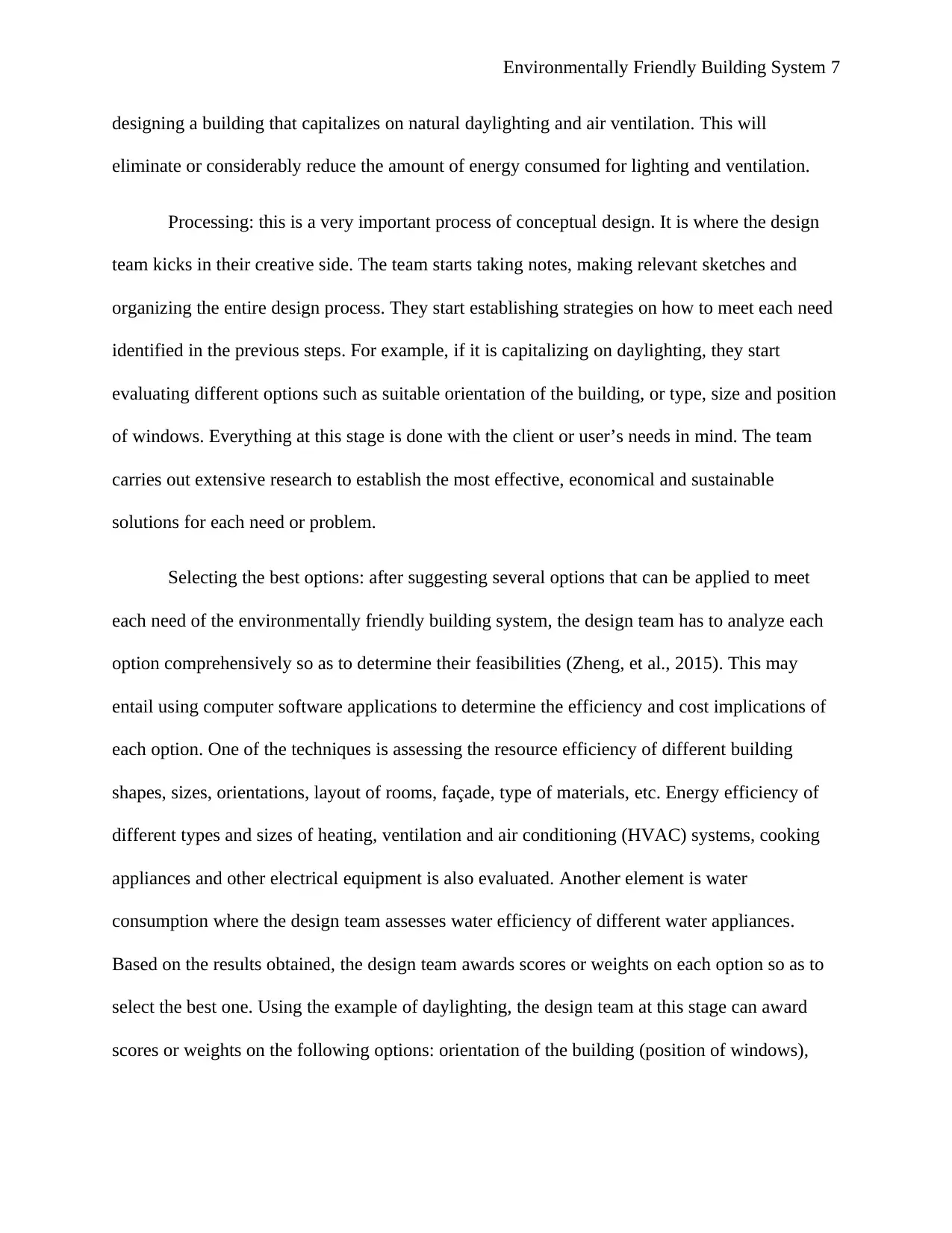
Environmentally Friendly Building System 7
designing a building that capitalizes on natural daylighting and air ventilation. This will
eliminate or considerably reduce the amount of energy consumed for lighting and ventilation.
Processing: this is a very important process of conceptual design. It is where the design
team kicks in their creative side. The team starts taking notes, making relevant sketches and
organizing the entire design process. They start establishing strategies on how to meet each need
identified in the previous steps. For example, if it is capitalizing on daylighting, they start
evaluating different options such as suitable orientation of the building, or type, size and position
of windows. Everything at this stage is done with the client or user’s needs in mind. The team
carries out extensive research to establish the most effective, economical and sustainable
solutions for each need or problem.
Selecting the best options: after suggesting several options that can be applied to meet
each need of the environmentally friendly building system, the design team has to analyze each
option comprehensively so as to determine their feasibilities (Zheng, et al., 2015). This may
entail using computer software applications to determine the efficiency and cost implications of
each option. One of the techniques is assessing the resource efficiency of different building
shapes, sizes, orientations, layout of rooms, façade, type of materials, etc. Energy efficiency of
different types and sizes of heating, ventilation and air conditioning (HVAC) systems, cooking
appliances and other electrical equipment is also evaluated. Another element is water
consumption where the design team assesses water efficiency of different water appliances.
Based on the results obtained, the design team awards scores or weights on each option so as to
select the best one. Using the example of daylighting, the design team at this stage can award
scores or weights on the following options: orientation of the building (position of windows),
designing a building that capitalizes on natural daylighting and air ventilation. This will
eliminate or considerably reduce the amount of energy consumed for lighting and ventilation.
Processing: this is a very important process of conceptual design. It is where the design
team kicks in their creative side. The team starts taking notes, making relevant sketches and
organizing the entire design process. They start establishing strategies on how to meet each need
identified in the previous steps. For example, if it is capitalizing on daylighting, they start
evaluating different options such as suitable orientation of the building, or type, size and position
of windows. Everything at this stage is done with the client or user’s needs in mind. The team
carries out extensive research to establish the most effective, economical and sustainable
solutions for each need or problem.
Selecting the best options: after suggesting several options that can be applied to meet
each need of the environmentally friendly building system, the design team has to analyze each
option comprehensively so as to determine their feasibilities (Zheng, et al., 2015). This may
entail using computer software applications to determine the efficiency and cost implications of
each option. One of the techniques is assessing the resource efficiency of different building
shapes, sizes, orientations, layout of rooms, façade, type of materials, etc. Energy efficiency of
different types and sizes of heating, ventilation and air conditioning (HVAC) systems, cooking
appliances and other electrical equipment is also evaluated. Another element is water
consumption where the design team assesses water efficiency of different water appliances.
Based on the results obtained, the design team awards scores or weights on each option so as to
select the best one. Using the example of daylighting, the design team at this stage can award
scores or weights on the following options: orientation of the building (position of windows),
Paraphrase This Document
Need a fresh take? Get an instant paraphrase of this document with our AI Paraphraser
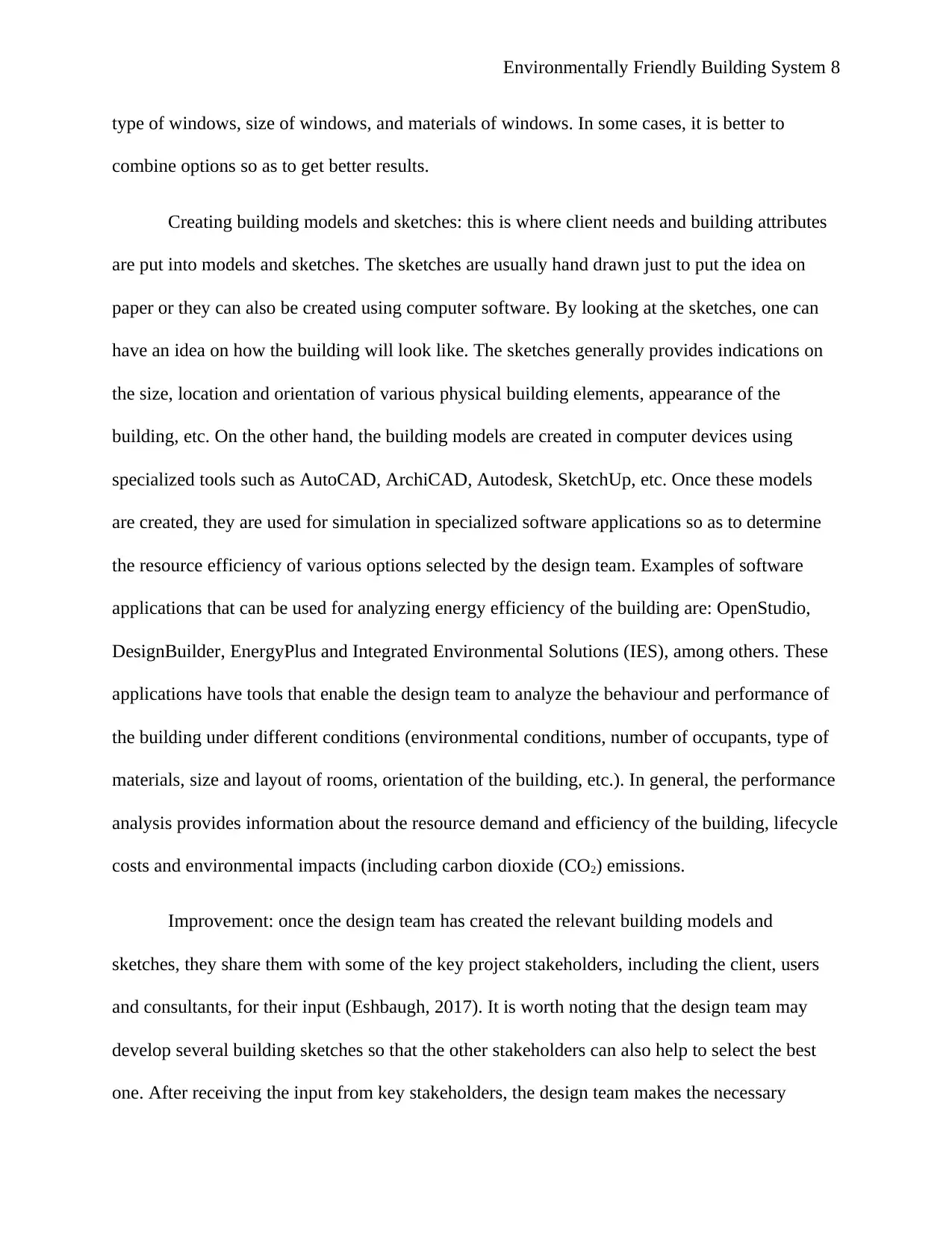
Environmentally Friendly Building System 8
type of windows, size of windows, and materials of windows. In some cases, it is better to
combine options so as to get better results.
Creating building models and sketches: this is where client needs and building attributes
are put into models and sketches. The sketches are usually hand drawn just to put the idea on
paper or they can also be created using computer software. By looking at the sketches, one can
have an idea on how the building will look like. The sketches generally provides indications on
the size, location and orientation of various physical building elements, appearance of the
building, etc. On the other hand, the building models are created in computer devices using
specialized tools such as AutoCAD, ArchiCAD, Autodesk, SketchUp, etc. Once these models
are created, they are used for simulation in specialized software applications so as to determine
the resource efficiency of various options selected by the design team. Examples of software
applications that can be used for analyzing energy efficiency of the building are: OpenStudio,
DesignBuilder, EnergyPlus and Integrated Environmental Solutions (IES), among others. These
applications have tools that enable the design team to analyze the behaviour and performance of
the building under different conditions (environmental conditions, number of occupants, type of
materials, size and layout of rooms, orientation of the building, etc.). In general, the performance
analysis provides information about the resource demand and efficiency of the building, lifecycle
costs and environmental impacts (including carbon dioxide (CO2) emissions.
Improvement: once the design team has created the relevant building models and
sketches, they share them with some of the key project stakeholders, including the client, users
and consultants, for their input (Eshbaugh, 2017). It is worth noting that the design team may
develop several building sketches so that the other stakeholders can also help to select the best
one. After receiving the input from key stakeholders, the design team makes the necessary
type of windows, size of windows, and materials of windows. In some cases, it is better to
combine options so as to get better results.
Creating building models and sketches: this is where client needs and building attributes
are put into models and sketches. The sketches are usually hand drawn just to put the idea on
paper or they can also be created using computer software. By looking at the sketches, one can
have an idea on how the building will look like. The sketches generally provides indications on
the size, location and orientation of various physical building elements, appearance of the
building, etc. On the other hand, the building models are created in computer devices using
specialized tools such as AutoCAD, ArchiCAD, Autodesk, SketchUp, etc. Once these models
are created, they are used for simulation in specialized software applications so as to determine
the resource efficiency of various options selected by the design team. Examples of software
applications that can be used for analyzing energy efficiency of the building are: OpenStudio,
DesignBuilder, EnergyPlus and Integrated Environmental Solutions (IES), among others. These
applications have tools that enable the design team to analyze the behaviour and performance of
the building under different conditions (environmental conditions, number of occupants, type of
materials, size and layout of rooms, orientation of the building, etc.). In general, the performance
analysis provides information about the resource demand and efficiency of the building, lifecycle
costs and environmental impacts (including carbon dioxide (CO2) emissions.
Improvement: once the design team has created the relevant building models and
sketches, they share them with some of the key project stakeholders, including the client, users
and consultants, for their input (Eshbaugh, 2017). It is worth noting that the design team may
develop several building sketches so that the other stakeholders can also help to select the best
one. After receiving the input from key stakeholders, the design team makes the necessary
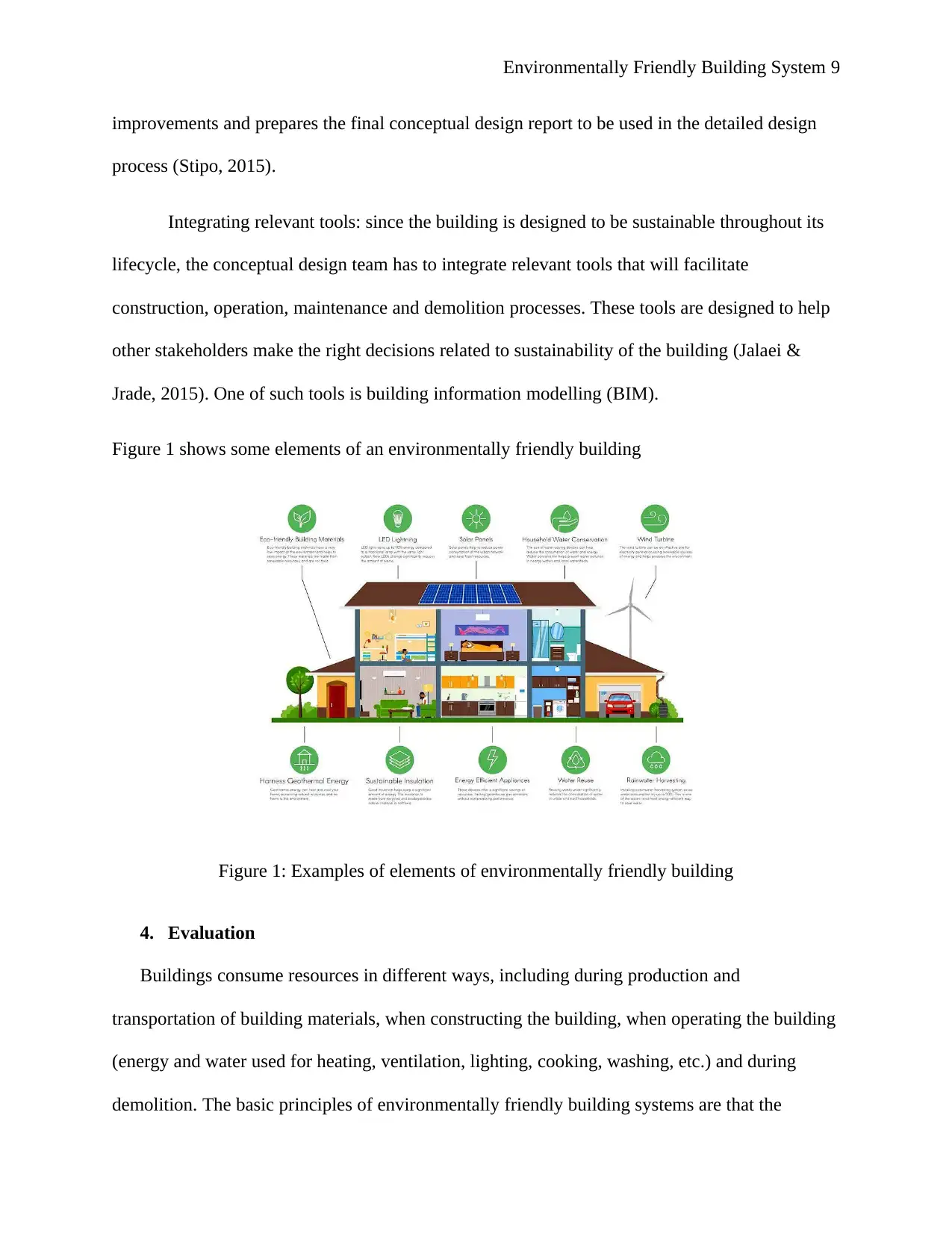
Environmentally Friendly Building System 9
improvements and prepares the final conceptual design report to be used in the detailed design
process (Stipo, 2015).
Integrating relevant tools: since the building is designed to be sustainable throughout its
lifecycle, the conceptual design team has to integrate relevant tools that will facilitate
construction, operation, maintenance and demolition processes. These tools are designed to help
other stakeholders make the right decisions related to sustainability of the building (Jalaei &
Jrade, 2015). One of such tools is building information modelling (BIM).
Figure 1 shows some elements of an environmentally friendly building
Figure 1: Examples of elements of environmentally friendly building
4. Evaluation
Buildings consume resources in different ways, including during production and
transportation of building materials, when constructing the building, when operating the building
(energy and water used for heating, ventilation, lighting, cooking, washing, etc.) and during
demolition. The basic principles of environmentally friendly building systems are that the
improvements and prepares the final conceptual design report to be used in the detailed design
process (Stipo, 2015).
Integrating relevant tools: since the building is designed to be sustainable throughout its
lifecycle, the conceptual design team has to integrate relevant tools that will facilitate
construction, operation, maintenance and demolition processes. These tools are designed to help
other stakeholders make the right decisions related to sustainability of the building (Jalaei &
Jrade, 2015). One of such tools is building information modelling (BIM).
Figure 1 shows some elements of an environmentally friendly building
Figure 1: Examples of elements of environmentally friendly building
4. Evaluation
Buildings consume resources in different ways, including during production and
transportation of building materials, when constructing the building, when operating the building
(energy and water used for heating, ventilation, lighting, cooking, washing, etc.) and during
demolition. The basic principles of environmentally friendly building systems are that the
⊘ This is a preview!⊘
Do you want full access?
Subscribe today to unlock all pages.

Trusted by 1+ million students worldwide
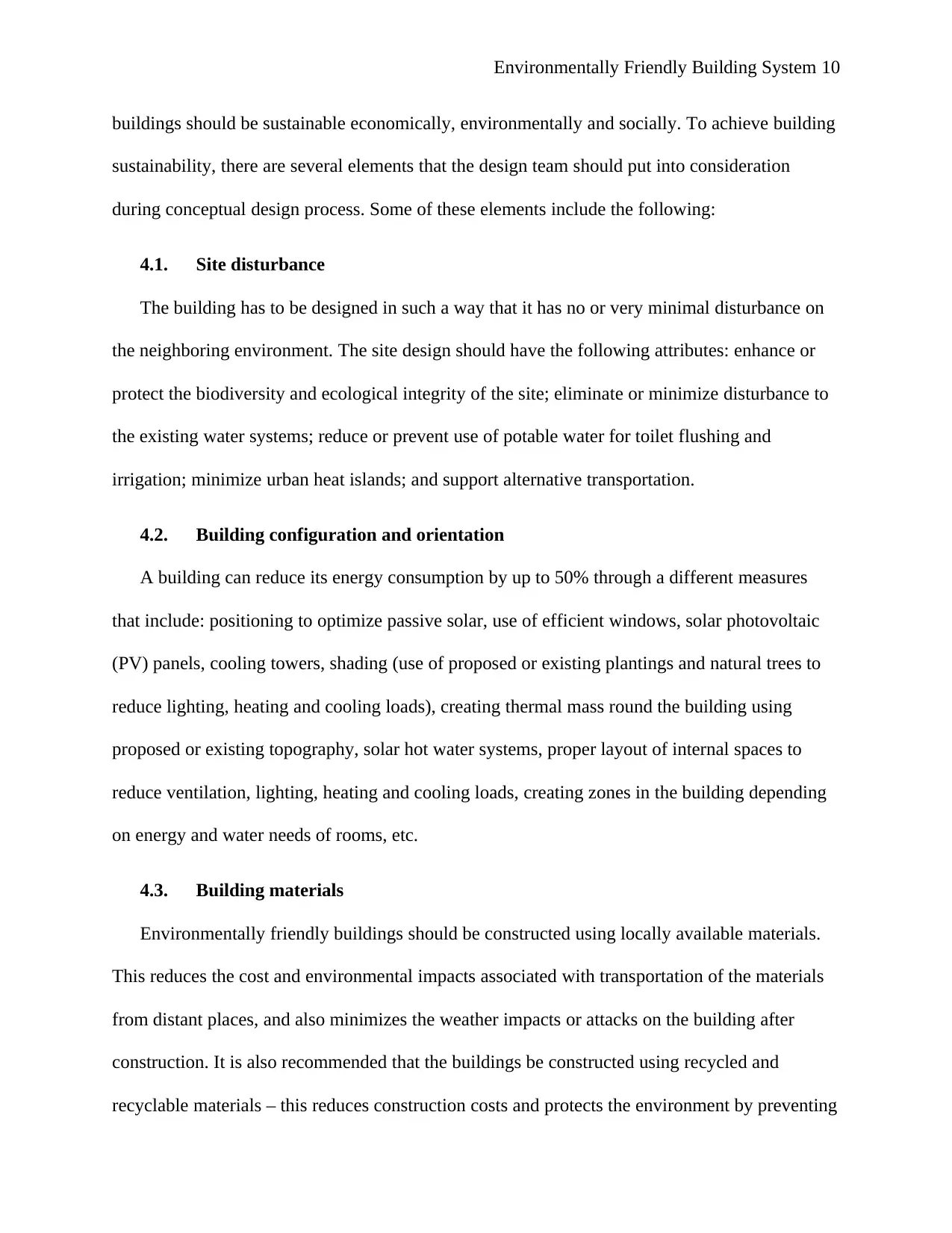
Environmentally Friendly Building System 10
buildings should be sustainable economically, environmentally and socially. To achieve building
sustainability, there are several elements that the design team should put into consideration
during conceptual design process. Some of these elements include the following:
4.1. Site disturbance
The building has to be designed in such a way that it has no or very minimal disturbance on
the neighboring environment. The site design should have the following attributes: enhance or
protect the biodiversity and ecological integrity of the site; eliminate or minimize disturbance to
the existing water systems; reduce or prevent use of potable water for toilet flushing and
irrigation; minimize urban heat islands; and support alternative transportation.
4.2. Building configuration and orientation
A building can reduce its energy consumption by up to 50% through a different measures
that include: positioning to optimize passive solar, use of efficient windows, solar photovoltaic
(PV) panels, cooling towers, shading (use of proposed or existing plantings and natural trees to
reduce lighting, heating and cooling loads), creating thermal mass round the building using
proposed or existing topography, solar hot water systems, proper layout of internal spaces to
reduce ventilation, lighting, heating and cooling loads, creating zones in the building depending
on energy and water needs of rooms, etc.
4.3. Building materials
Environmentally friendly buildings should be constructed using locally available materials.
This reduces the cost and environmental impacts associated with transportation of the materials
from distant places, and also minimizes the weather impacts or attacks on the building after
construction. It is also recommended that the buildings be constructed using recycled and
recyclable materials – this reduces construction costs and protects the environment by preventing
buildings should be sustainable economically, environmentally and socially. To achieve building
sustainability, there are several elements that the design team should put into consideration
during conceptual design process. Some of these elements include the following:
4.1. Site disturbance
The building has to be designed in such a way that it has no or very minimal disturbance on
the neighboring environment. The site design should have the following attributes: enhance or
protect the biodiversity and ecological integrity of the site; eliminate or minimize disturbance to
the existing water systems; reduce or prevent use of potable water for toilet flushing and
irrigation; minimize urban heat islands; and support alternative transportation.
4.2. Building configuration and orientation
A building can reduce its energy consumption by up to 50% through a different measures
that include: positioning to optimize passive solar, use of efficient windows, solar photovoltaic
(PV) panels, cooling towers, shading (use of proposed or existing plantings and natural trees to
reduce lighting, heating and cooling loads), creating thermal mass round the building using
proposed or existing topography, solar hot water systems, proper layout of internal spaces to
reduce ventilation, lighting, heating and cooling loads, creating zones in the building depending
on energy and water needs of rooms, etc.
4.3. Building materials
Environmentally friendly buildings should be constructed using locally available materials.
This reduces the cost and environmental impacts associated with transportation of the materials
from distant places, and also minimizes the weather impacts or attacks on the building after
construction. It is also recommended that the buildings be constructed using recycled and
recyclable materials – this reduces construction costs and protects the environment by preventing
Paraphrase This Document
Need a fresh take? Get an instant paraphrase of this document with our AI Paraphraser
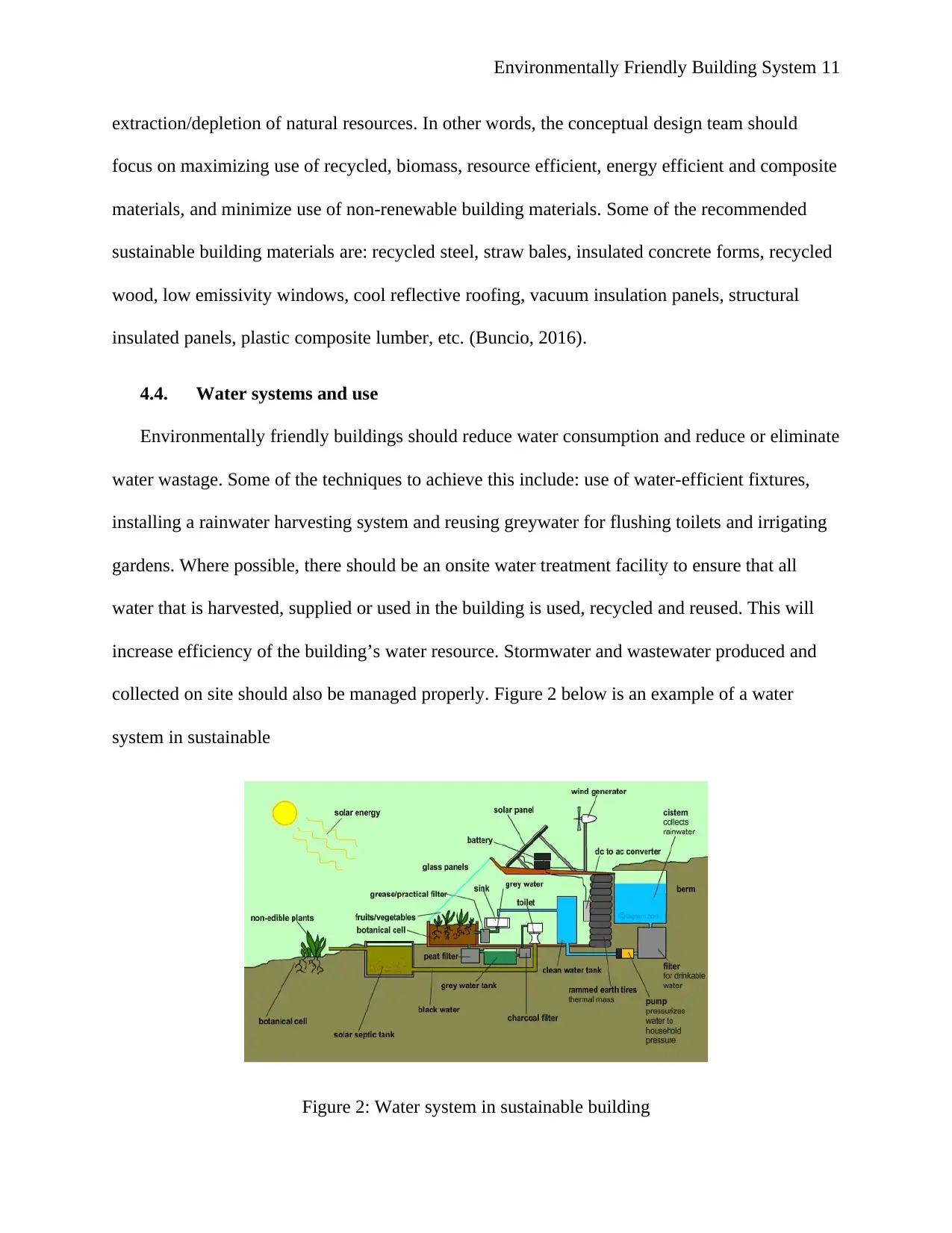
Environmentally Friendly Building System 11
extraction/depletion of natural resources. In other words, the conceptual design team should
focus on maximizing use of recycled, biomass, resource efficient, energy efficient and composite
materials, and minimize use of non-renewable building materials. Some of the recommended
sustainable building materials are: recycled steel, straw bales, insulated concrete forms, recycled
wood, low emissivity windows, cool reflective roofing, vacuum insulation panels, structural
insulated panels, plastic composite lumber, etc. (Buncio, 2016).
4.4. Water systems and use
Environmentally friendly buildings should reduce water consumption and reduce or eliminate
water wastage. Some of the techniques to achieve this include: use of water-efficient fixtures,
installing a rainwater harvesting system and reusing greywater for flushing toilets and irrigating
gardens. Where possible, there should be an onsite water treatment facility to ensure that all
water that is harvested, supplied or used in the building is used, recycled and reused. This will
increase efficiency of the building’s water resource. Stormwater and wastewater produced and
collected on site should also be managed properly. Figure 2 below is an example of a water
system in sustainable
Figure 2: Water system in sustainable building
extraction/depletion of natural resources. In other words, the conceptual design team should
focus on maximizing use of recycled, biomass, resource efficient, energy efficient and composite
materials, and minimize use of non-renewable building materials. Some of the recommended
sustainable building materials are: recycled steel, straw bales, insulated concrete forms, recycled
wood, low emissivity windows, cool reflective roofing, vacuum insulation panels, structural
insulated panels, plastic composite lumber, etc. (Buncio, 2016).
4.4. Water systems and use
Environmentally friendly buildings should reduce water consumption and reduce or eliminate
water wastage. Some of the techniques to achieve this include: use of water-efficient fixtures,
installing a rainwater harvesting system and reusing greywater for flushing toilets and irrigating
gardens. Where possible, there should be an onsite water treatment facility to ensure that all
water that is harvested, supplied or used in the building is used, recycled and reused. This will
increase efficiency of the building’s water resource. Stormwater and wastewater produced and
collected on site should also be managed properly. Figure 2 below is an example of a water
system in sustainable
Figure 2: Water system in sustainable building
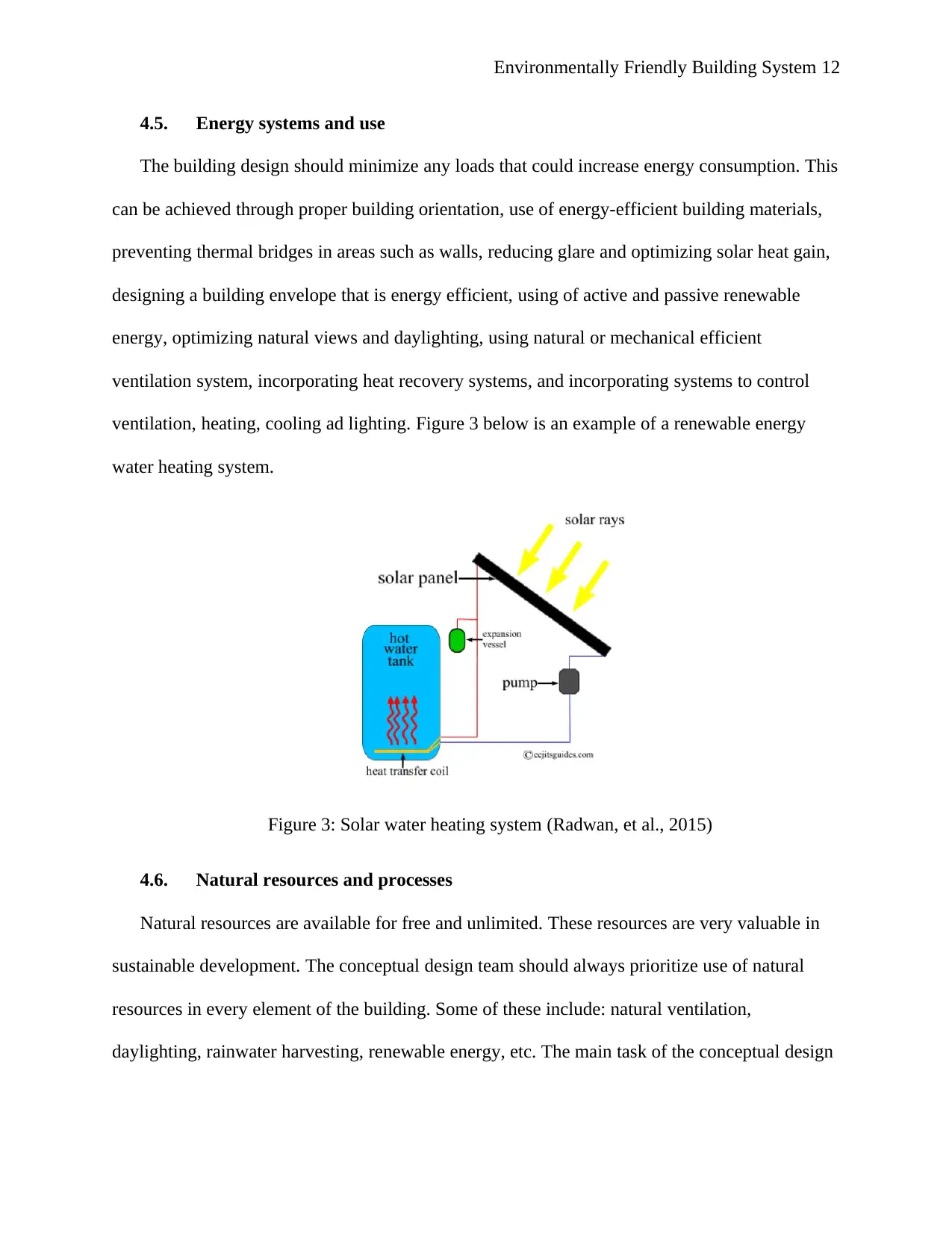
Environmentally Friendly Building System 12
4.5. Energy systems and use
The building design should minimize any loads that could increase energy consumption. This
can be achieved through proper building orientation, use of energy-efficient building materials,
preventing thermal bridges in areas such as walls, reducing glare and optimizing solar heat gain,
designing a building envelope that is energy efficient, using of active and passive renewable
energy, optimizing natural views and daylighting, using natural or mechanical efficient
ventilation system, incorporating heat recovery systems, and incorporating systems to control
ventilation, heating, cooling ad lighting. Figure 3 below is an example of a renewable energy
water heating system.
Figure 3: Solar water heating system (Radwan, et al., 2015)
4.6. Natural resources and processes
Natural resources are available for free and unlimited. These resources are very valuable in
sustainable development. The conceptual design team should always prioritize use of natural
resources in every element of the building. Some of these include: natural ventilation,
daylighting, rainwater harvesting, renewable energy, etc. The main task of the conceptual design
4.5. Energy systems and use
The building design should minimize any loads that could increase energy consumption. This
can be achieved through proper building orientation, use of energy-efficient building materials,
preventing thermal bridges in areas such as walls, reducing glare and optimizing solar heat gain,
designing a building envelope that is energy efficient, using of active and passive renewable
energy, optimizing natural views and daylighting, using natural or mechanical efficient
ventilation system, incorporating heat recovery systems, and incorporating systems to control
ventilation, heating, cooling ad lighting. Figure 3 below is an example of a renewable energy
water heating system.
Figure 3: Solar water heating system (Radwan, et al., 2015)
4.6. Natural resources and processes
Natural resources are available for free and unlimited. These resources are very valuable in
sustainable development. The conceptual design team should always prioritize use of natural
resources in every element of the building. Some of these include: natural ventilation,
daylighting, rainwater harvesting, renewable energy, etc. The main task of the conceptual design
⊘ This is a preview!⊘
Do you want full access?
Subscribe today to unlock all pages.

Trusted by 1+ million students worldwide
1 out of 17
Related Documents
Your All-in-One AI-Powered Toolkit for Academic Success.
+13062052269
info@desklib.com
Available 24*7 on WhatsApp / Email
![[object Object]](/_next/static/media/star-bottom.7253800d.svg)
Unlock your academic potential
Copyright © 2020–2025 A2Z Services. All Rights Reserved. Developed and managed by ZUCOL.





